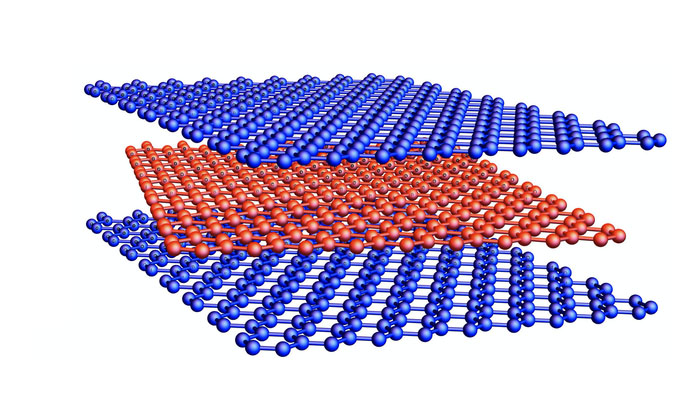| Apr 27, 2022 |
Glimpse inside a graphene sandwich
(Nanowerk News) Since the first successful fabrication of a two-dimensional structure of carbon atoms about 20 years ago, graphene has fascinated scientists. A few years ago, researchers discovered that two layers of graphene, slightly twisted against each other, can conduct electric current without loss.
|
 |
| Honeycomb-shaped structures made of carbon atoms, known as graphene, can conduct electric current without resistance when twisted against each other. (Image: University of Innsbruck)
|
|
In recent years, this discovery has prompted scientists to explore such layered materials in greater detail. A recent notable example is mirror-symmetric twisted trilayer graphene, where three layers of graphene are stacked with alternating twist angles. It is the first moiré system that can both be efficiently tuned with a perpendicular electric field and was demonstrated experimentally to exhibit robust superconductivity, alongside various other phases.
|
|
“This establishes trilayer graphene as an exciting platform for complex many-body physics, but the nature of the observed interaction-induced insulators, semi-metals, and superconductivity remains unknown”, says Mathias Scheurer from the Department of Theoretical Physics of the University of Innsbruck.
|
|
In a paper published in Physical Review X ("Correlated insulators, semimetals, and superconductivity in twisted trilayer graphene"), a team led by Scheurer numerically and analytically studied the phase diagram of this system for different numbers of electrons per moiré unit cell and as a function of electric field.
|
|
“This is a very challenging problem as the system has both flat and highly dispersive bands”, says the theoretical physicist. “Nonetheless, we managed to show that the ground state of the system in the absence of a field decouples into a product of the ground state of graphene and the ground state of twisted bilayer graphene”, a property that has subsequently been confirmed by experiments.
|
|
Their results further establish the dominance of insulating and semi-metallic phases in the presence of an electric field which are unique to the trilayer system, i.e., are not realized in twisted bilayer graphene.
|
|
“We are able to use our resulting phase diagram for the correlated normal states to constrain the form of the superconductor”, says Scheurer. “Among other aspects, the resulting two superconducting candidate states we get are consistent with the unexpected stability of the superconductor in magnetic field seen in experiment.”
|
|
The relevance of the findings for the physics of twisted trilayer graphene is further attested by a subsequent collaboration with the group of Abhay Pasupathy from Columbia university. In a recent paper in Science, they report scanning tunneling microscopy (STM) data on this system. “We show that the measured tunneling spectra exhibit significant interaction effects that can be qualitatively captured by the numerics of our work”, says Mathias Scheurer.
|

